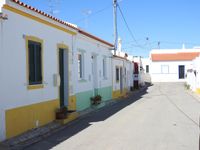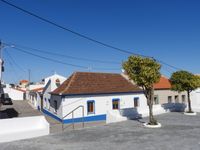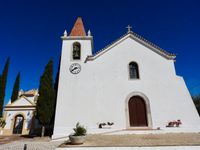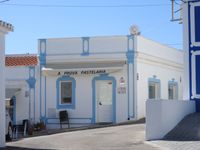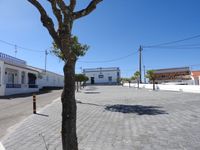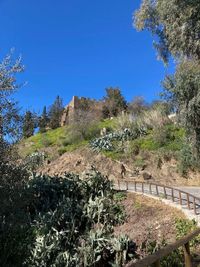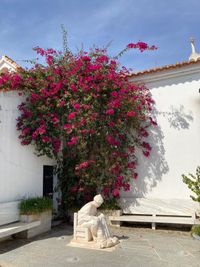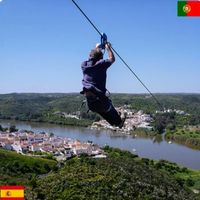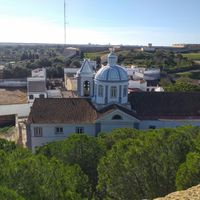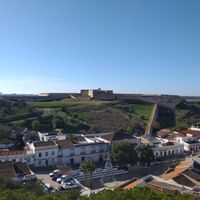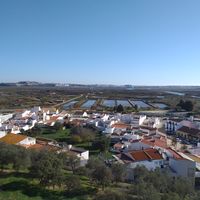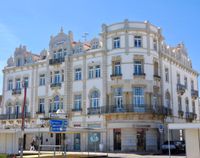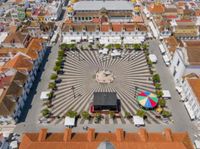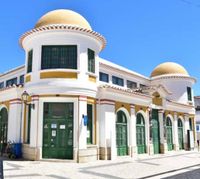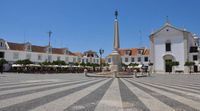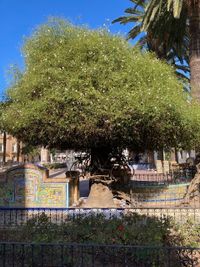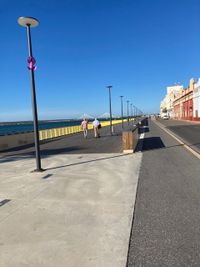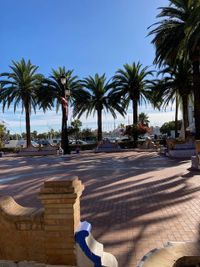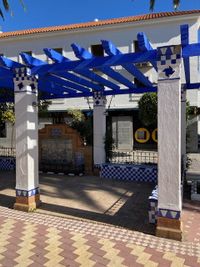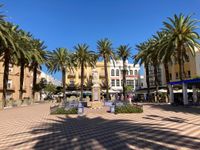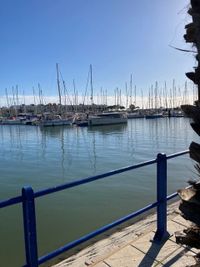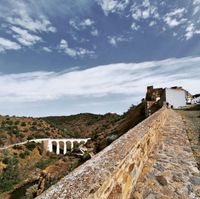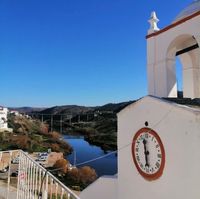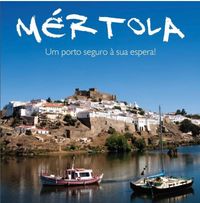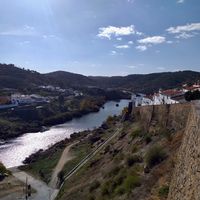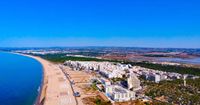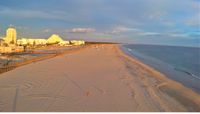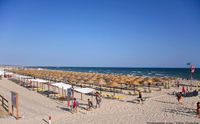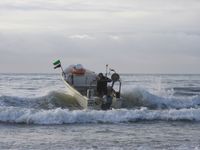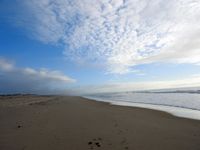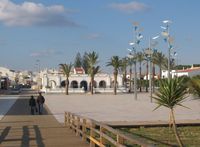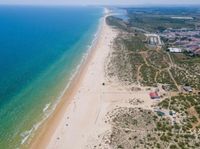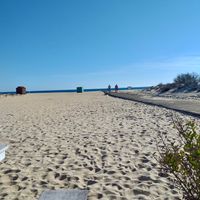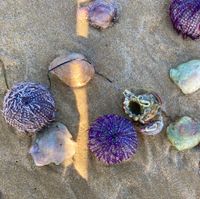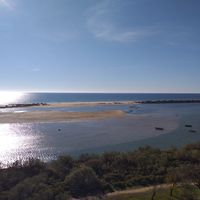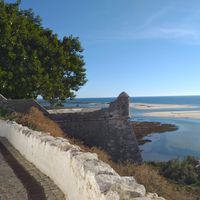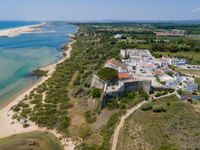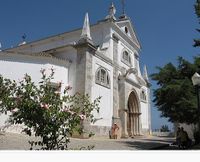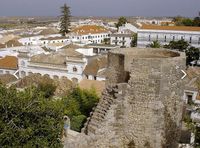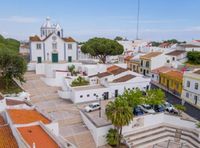Surroundings
Azinhal
The village of Azinhal is surrounded by hiking trails and is located on the edge of the Rio Guadiana. Hikers and nature lovers in particular can indulge themselves here. From the village you have beautiful views.
The pastelaria in the village of 'A Prova' is well known in the region for its delicious pastries and delicacies. The village also has an Amanhecer supermercado with an extensive range. Here you can also get fresh bread from 09:00 in the morning.
On the outskirts of the village you will find the cultural center of the Castro Marim region, which regularly hosts cultural events related to agricultural activities and animal husbandry. There is also an exhibition space and a goat cheese factory. You can buy fresh goat cheese here every morning.
The village also has 2 cafes, an ATM, a post office and a petrol station.
Every last Sunday of the month there is a small cozy market on the square where local products are sold and where we eat together.
Alcoutim
The village of Alcoutim has a rich history formed by the war with the Spaniards. It is located directly on the Guadiana River with the Spanish village of San Lucar de Guadiana on the other side, which can be reached via the ferry that sails back and forth daily. It is a beautiful place to visit with many terraces and restaurants on the waterfront. From the castle you can look out over the river, the town of San Lucar and the fortress of the Spaniards. The castle has a beautiful garden and there is a museum with archaeological finds.
Near the river bank is the Igreja Matriz do Salvador de Alcoutim. This church was built in the 16th century and is one of the earliest examples of Renaissance architecture in the Algarve. Above the door you can see the coat of arms of the Marquises of Vila Real and the Counts of Alcoutim. In the center is the Ermida de Nossa Senhora da Conceição. Church of Saint Mary. Special is the altar decorated with 16th century Spanish Arab tiles and a baroque altarpiece with gilded carvings and columns with symbolic figures.
The reason Alcoutim was once rich is that the Guadiana is a tidal river. The Romans and later the Visigoths and the Moors, mined iron and copper in the area. They melted it down and shipped it down the river to the Mediterranean and beyond. Ships often had to wait hours here before the water was high enough to continue sailing.
For the sporty types, there is Zipline with which you can zip from country to country. Alcoutim also has a small beach on the river, Praia Fluvial, with a cozy restaraurant/bar where music performances regularly take place.
Castro Marim
10 minutes by car to the south, in the nature reserve Sapo and the salt flats, is the town of Castro Marim with narrow streets and picturesque houses.
The town has a medieval castle and a star-shaped fortress, Forte de São Sebastião. Whoever visits the castle on the hill has a beautiful view of the Guadiana river on one side, with the town of Ayamonte on the banks, in the distance you can see the deep blue sea and on the other side the green hills of the Algarve. The courtyard of the castle is also very worthwhile for enthusiasts. At the rear of the church you will find a medieval cafe where a small street fair is regularly held. Another beautiful building is the Moinho de Vento. This white mill is well maintained and still in use.
The center of Castro Marim is cozy with several cafes and restaurants. Every 2nd Saturday of the month there is a large market with many local products, clothing, fruit and handicrafts.
In the nature reserve around the town you can even spot flamingos and if you want to relax for a day, visit the Spa in the middle of the salt flats.
Every year at the end of August there is a medieval festival (Dias Mediavais) that brings together many people from all over the world to perform, such as medieval musicians, archers, swordsmen, dancers, etc. The rich history is celebrated and commemorated here every year.
Vila Real de Santo António
The charming harbor town of Vila Real de Santo António, just 3 km east of Monte Gordo, has been a natural border for over 2,000 years, originally forming the boundary between the Roman provinces of Lusitania (Portugal) and Baetica (southern Spain).
Vila Real de Santo Antonio is oriented towards a large, airy and beautifully paved square with in the center an obelisk from 1776 in memory of King José I. Submerged by the sea in the 17th century, it was rebuilt by the Marquês de Pombal as a kind of model similar to the Baixa district in Lisbon, making the city architecturally unique in the Algarve.
You can stroll through the many shopping streets and the range of cafes and restaurants is large and diverse. In the beautiful Moorish cultural center you can visit interesting exhibitions. The local covered market (Mercado Municipal), located just before the center, offers a fresh range of local products every morning.
From the quay you can take the ferry to Ayamonte every hour every day, if desired you can also take your bicycle or scooter with you. The river cruises also offer visitors a fun day, with stops in some of Portugal's most picturesque and unhurried villages.
Or walk along the boulevard from the marina all the way to the mouth of the sea and enjoy the beautiful view of the river and the town of Ayamonte and the special buildings, such as the beautiful Grande Hotel Guadiana. For the luxury connoisseurs among us, this hotel also offers a beach club on the edge of the Guadiana river where you can enjoy a delicious meal.
Ayamonte
At the other side of the river from Vila Real is the cozy Spanish town of Ayamonte. The lively town is located on a hill and has white houses, narrow shopping streets and beautiful tiled squares.
The square Plaza de la Coronacíon is one of the most characteristic places of Ayamonte with palm trees, benches and fountains with colorful tiles and good restaurants. In terms of culture, Ayamonte has beautiful old monasteries and churches, so definitely worth a visit.
At the highest point of the city, on the ruins of an old Roman castle, stands the Parador hotel with a magnificent view of the river and city. Especially nice at the end of the day for a drink on the terrace.
You can drive to Ayamonte via the bridge or take the ferry in Vila Real. The Spaniards use a slightly later lunch time than the Portuguese, but it is immediately an hour later in time. If you enter Ayamonte via the bridge, you will find the Spanish supermarket Mercadona and Lidl on the left side of the ring road. If you keep to the marina, you will automatically come across parking facilities to explore Ayamonte for a day.
It is also worth driving to Isla Canela, you will then drive through a beautiful nature reserve.
Mertóla
This beautiful village in the Alentejo, just across the border from the Algarve, is steeped in history. The city has a number of merits of historical importance to its name, being a former Roman city, the capital of an Arab empire and the first establishment of the Order of Santiago. It was the northernmost port of the Guadiana River, the major waterway from the south transported black metals from the region to the sea. Mértola preserves valuable treasures from the Romans, Suevi, Arabs and finally the Portuguese, who conquered the city in 1268, which are housed in various museums.
The village has been revived thanks to the intervention of archaeologists who have created a new concept with the open-air museum, also integrating the recovery of traditional culture and handicrafts.
You can enjoy walking through these irregular, often steep, streets. Be sure to visit the artisans in the workshops to learn about traditional handicrafts. And be sure to taste the delicious Alentejano cuisine while enjoying the view over the river.
Monte Gordo
For enthusiasts, the popular seaside resort of Monte Gordo is also within easy reach. Monte Gordo is the main tourist center of the Eastern Algarve, situated close to Vila Real de Santo Antonio. This former fishing village has grown into an important seaside resort with a beautiful wide and well-maintained sandy beach with many facilities such as restaurants, sun beds with parasols and entertainment in high season.
For the more authentic restaurants, go to the end of the boulevard where the fishermen of Monte Gordo enjoy their snack and drink.
As well as having the largest beach in the Algarve, Monte Gordo also has the warmest water, thanks in large part to its Mediterranean climate and favored geographical location near the mouth of the Guadiana River. Bordered by tall pines, the long and very wide sand stretches unbroken for several kilometers.
The town's casino overlooks the beach and is one of the eastern Algarve's top attractions. The casino opened in 1996 and features approximately 300 slot machines and regular musical performances.
Manta Rota
Manta Rota is a small seaside resort and consists mainly of holiday homes, making it particularly quiet in autumn and winter. The village has a fantastic wide white sandy beach with a nice restaurant in the dune edge here and there. Much of the sea is shallow and safe. The village has several restaurants and terraces and in the summer season a local covered market and various stalls.
Cacela Velha
Further west takes you to Cacela Velha, a pretty little town founded by the Phoenicians with a pretty church square overlooking the lagoon against a backdrop of several beaches. The church itself dates from the 16th century and has a beautiful Renaissance main door and a Gothic side door.
The beach at Cacela Velha, Praia da Fabrica, is truly beautiful. At low tide you can cross the lagoon of the natural park here. Although favored by the locals, it is still very unspoilt and there are no catering establishments.
Tavira
The lively town of Tavira is located in the middle of the Ria Formosa Natural Park. Although it is busier and more touristy than the places on the border river, it is a very charming town with plenty of attractions.
Tavira is famous for its many churches and the Ponte Romana, the Romanesque bridge that spans the river and connects the city's east and west banks. On the east side of the river you will find the old working-class neighborhood with many nice cafes and restaurants and terraces on the water. On the west side you will find the historic center and the old market halls.
